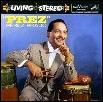Salsa & Mambo FAQ
By Enio Cordoba
Where did the term Salsa come from? I read in Latin Beat magazine that Chano Pozo and some of the others used to call out "Salsa!" (which means "sauce" as in hot sauce) during the really hot jams. Another story is that like a good sauce, they added more and more ingredients from the jazz influence so that it mutated the Danzon roots. Remember this stuff was called Latin Jazz in the 40's & 50's. When Latin music underwent a resurgence, in the 80's, rather than reviving a dead horse, the movers and shakers gave it the term Salsa and the dance caught fire.
In theory Salsa and Mambo are really the same dance. They are both based on the Clave beat, yet the feel is totally different. Musically it's still Mambo yet mutated. When you hear the Salsa bands they are usually playing slower than the bands of 10 years ago. Listen to El Gran Combo (the #1 Puerto Rican band for decades)--their stuff is really fast. Listen to Niche, Oscar D'Leon, Hansel Martinez. They will occasionally play something fast but usually its slower than Mambo.
What's the difference step-wise? Primarily, which country's style you are doing. Colombians though Salvadorans dance more side to side like an off time Samba whisk which is because of the Cumbia influence. Cubans and Puerto Ricans dance more forward and back which comes from the Mambo influence. All the young Salsa kids in the clubs are doing more of a nightclub two-step (yes, Buddy Schwimmer's) version than anything else. Why? Because Salsa is a street dance, the best dancers in a club set the style, create the moves and everyone copies them. 1) Mambo originated in Cuba but it was discovered in Mexico where Pérez Prado made it famous. 2) The best dancers dance Mambo on the 2 beat not because the beat is there but because they dance their hips on the 1 and fall into the 2 on a forward beat. The salsa dancers still use the body but not in the same fashion as one would in Mambo. 3) Most Cubans dance on 2, and from what I have heard most Puerto Ricans do as well. Those that break on one are usually untrained dancers or what many people call foot dancers. Puerto Rican style looks different from Cuban style with a lowered shoulder into the break while Cuban dancers dance more upright, but otherwise pattern-wise they still do the forward-back Mambo pattern.
Having trained in both Mambo and Salsa, I dance Mambo when the music has an edge to it. Mambo steps are cut. By that I mean Mambo has a quick feet-hold feeling while Salsa has a undulating feeling more like an ocean wave. While Mambo is a stop in the middle dance, many salsa dancers close feet on the end of the pattern (where most mambo dancers would rock fwd or back). An advanced Salsa basic is close, fwd, fwd pause, close back back pause. the feet have much less tone, foot arch, but the feet are much more active because they are always either flicking or dragging the slow.
Salsa dancers invariably break on 1 or 3. Untrained dancers hear the strong beat on 1 and step on it. The more Latin they are, the more they break on 3. Why? They usually hear it as SQQ because of the dead 2 beat. If you are dancing SQQ, to dance a slow you don't do Q, hold2, QQ-- you would move through the 1, landing on 2, which makes it a slow, and then do QQ on 34. (Yes that puts the feet on 2, 3, 4).
Enio Cordoba is a professional dance instructor based in Los Angeles.
Source: rec.arts.dance FAQ.
 |
 |
 |
 |
 |
Main Page |
Biography |
Site Map & Links |
This Record? |
|---|